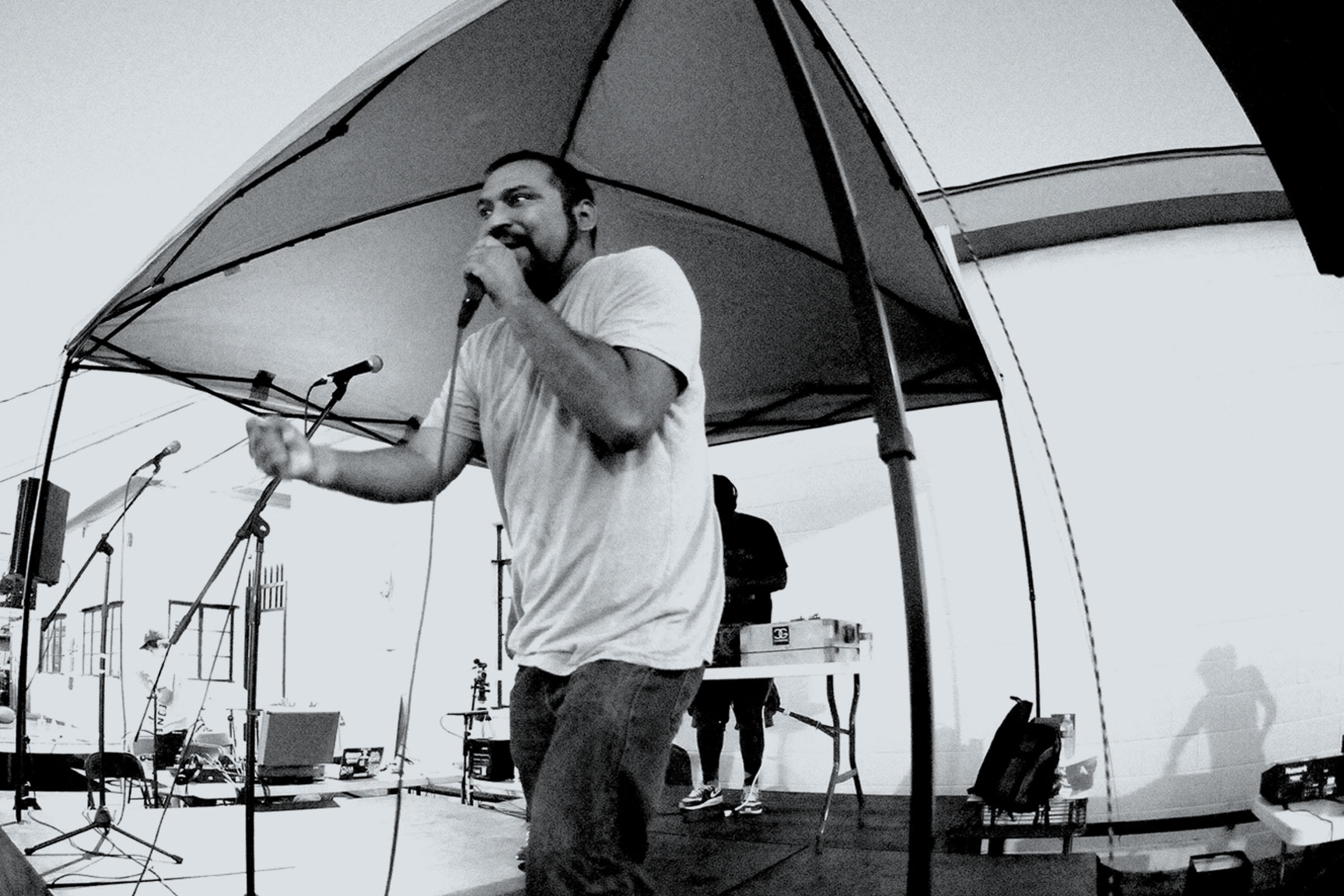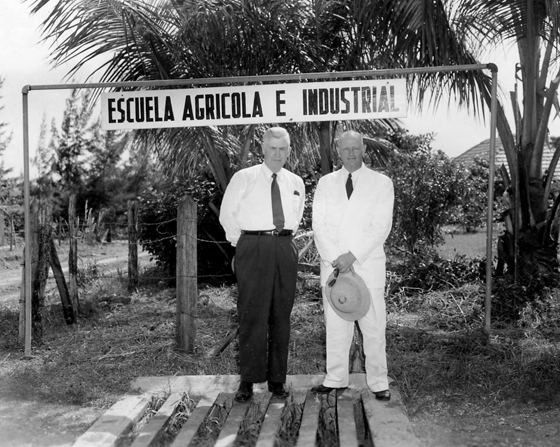


Dr. Robert Milk, right, at La Escuela Agrícola e Industrial in Cuba.
Dr. Robert Milk has come a long way from the rural landscape of Cuba where he grew up; literally and metaphorically. A son of two educators, teaching and the ability to share knowledge seems to flow though his veins. Milk joined the faculty at The University of Texas at San Antonio (UTSA) in 1980, and has spent the last 12 years as department head of Bicultural-Bilingual Studies in the College of Education and Human Development. In the fall of 2012, Milk retired from his current position, but by no means does he plan to stop teaching, sharing, and researching successful educational approaches grounded in stories from his past.
Milk’s personal experience with bilingualism began not by choice, but by circumstance. When he was a mere 10 months old, his parents were offered, and accepted, positions to help start an agricultural school in eastern Cuba. There, the family spoke English at home, and Spanish everywhere else.
“We traveled eight kilometers in a one-car train to our one-room schoolhouse, grades one through eight,” Milk recalled. “It was a company [sugar company] school, we didn’t belong there, but the school officials allowed us to go.”
After school, Milk would return to his home at the agricultural school and, even though his father discouraged it, play and talk with the teenagers who lived and went to school there.
“The students came from all over eastern Cuba,” he said. “They would study half the day, and work on the school farm the other half of the day. I wasn’t supposed to be in the dormitory with them in order to not interrupt their routine. And they were teenage boys, I am sure my father was worried about me being wrongly influenced. But I just ignored him. I practically lived down there, and when I heard that he [my father] was coming, I would go climb up the wall and hide in the rafters.”
The years passed, and through his life experiences and studies in the bilingual school he attended (half-day English and half-day Spanish) Milk became fully bilingual and biliterate. At age 13, Milk’s parents sent him to a boarding school in the Eastern United States because in Cuba, the closest high school he could attend was 900 kilometers away in Havana. Milk went to school for a year, and then returned to Cuba in the summer of 1960. Little did he know that trip would be his last visit home for four decades.
“That fall, wives and children of U.S. citizens were ordered to leave Cuba, and then in January of 1961, my father received a notice from the Embassy in Havana to leave,” Milk recalled. “He was the last American in Eastern Cuba to leave, and he had to do it quietly in the night in order for the school to continue operating. He wasn’t able to take anything. No one wanted him to leave, but he did, and two months later, the Bay of Pigs happened. Never in our wildest dreams did we think we wouldn’t be going back. That was my home.”
Milk says that his childhood in Cuba established his interest in the study of bilingual education. When he began his studies as a graduate student in the late 1960s, there wasn’t an area of specialization in bilingual education. He focused his studies first in history and Spanish, and later applied linguistics, because it was as close as he could get to bilingual education and dealing with the issues that interested him. Upon completing his master’s in education, he had the opportunity to work in Peru with the Peace Corps, and was a founding faculty member for a normal school there.
“It was a great job for someone in their mid-20’s and that is what really got me interested in teacher training,” he said. “The whole purpose of our involvement was to prepare teachers in an instructional approach that promoted learning through interactive activities that stimulated understanding, and that helped students think, not just memorize.”
In Milk’s time at the school, he had the opportunity to take his normalista students to observe at the adjoining Lab School. One of the teachers was teaching her 50 first-grade students though music and drama, and he was enthralled.
“I would take my students to her class, and that is how my wife and I met,” Milk recalled.
After his time in Peru, Milk and his new bride moved back to the States, where there were a multitude of new opportunities in bilingual education. Prior to 1969, it was illegal to speak Spanish in Texas classrooms. However, during that same year, a law passed that made native language instruction in the classroom legal and dramatically changed the state's educational landscape.
“I look at everything that has happened in my professional career as a question of incredible timing,” he said. “Bilingual ed really started in the states when I was in Peru, so when I came back, I taught Spanish and ESL. I decided what I really wanted to do required a doctoral degree and I ended up receiving a fellowship at Stanford.”
While at Stanford, Milk read in a professional journal about a new organization, the National Association for Bilingual Education (NABE), housed in a bicultural, bilingual studies division at a brand-new university, UTSA, in the city of San Antonio, Texas.
“That was my field and at that time, there was no such thing as a university department focusing specifically in this new area. Anywhere!” he recalled. “I thought, ‘That is cool’ and sent in five dollars to the division of bicultural-bilingual studies at UTSA to join this new organization called NABE.”
The program was on Milk’s radar throughout his doctorate. When he finished his degree, he had a number of job opportunities, one of which was at UTSA. He flew down to San Antonio for an interview, and decided that San Antonio was where he wanted to be.
Milk started teaching at UTSA in 1980, and at that time, the bilingual division had one degree program - a master’s in bicultural/bilingual studies, and had recently developed certification programs in the new teaching areas of bilingual education and English as a Second Language (ESL). There was a huge need for certified teachers in these areas, which only ten years earlier did not even exist as teaching fields.
“All this retraining had to be done for existing teachers,” Milk said. “Our department was very important for San Antonio, and beyond. That was exciting.”
Throughout the next 32 years, Milk has seen the program evolve to where it now stands as a department offering three undergraduate programs, two minors, two master’s programs and a doctoral program. Though it was never Milk’s goal to work in administration, that is where he has ended up.
“I love teaching,” he said. “I never wanted to do any of this [administration work] but in 1989 the director of the division left, and basically they told me that the Dean and faculty wanted me to be acting director. I didn’t want to do it.”
But he did and served in that position for 17 years before he became Chair of the Department of Bicultural-Bilingual Studies in 2007. As department head, Milk was the driving force behind obtaining over eight million dollars in grants given to students enrolled in the program and conducting research.
“With these grants, we were able to impact the teaching profession,” Milk said. “The whole infrastructure for bilingual ed in San Antonio was deeply influenced by what the BBL division did here at UTSA. In the course of all that, we obtained a national reputation.”
Milk’s time as department chair has passed, and he is excited for what the future will bring. He is going to focus on researching original documents in order to tell the story of La Escuela Agrícola e Industrial, a case study of educational transformation where his parents taught in Cuba and where he spent his childhood.
“The story of the school in Cuba needs to be told,” he said. “I do it partly for my own personal satisfaction, and out of a sense that there is something interesting and unique about what happened there — in particular, the dramatic transformation of lives of rural youth through highly innovative pedagogy and experiential education — that has not been written about.”
As well as writing, Milk plans to return to the COEHD in Spring 2013 to teach. This will allow him to maintain contact with the students, which he says satisfies him on the deepest level. In his departure, Milk leaves behind a legacy of dedication, service, and a bilingual edge for all learners.